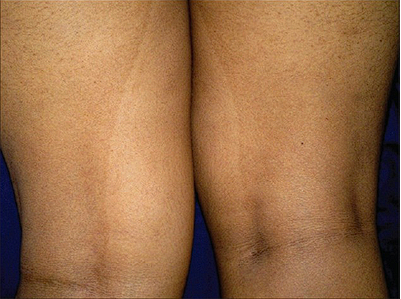How to Identify Pigmentary Demarcation Lines?

Pigment demarcation lines reflect natural differences in melanin distribution and are usually divided into five types:
Type A, pigmentation lines run along the upper extremities with varying degrees of transthoracic extension.
Type B, pigmentation lines running along the posterior midline of the lower extremities, which usually first appear during pregnancy.
Type C, paired pigmentation lines running along the midline or paramedian line of the chest extending toward the abdomen.
Type D, pigmentation lines run along the posterior midline of the spine.
Type E: bilaterally symmetrical, oblique hypopigmented spots on the chest. The pigmentation lines are relatively stable and do not seem to extend after they appear. In some cases, the hypopigmented spots may gradually disappear during the growth and developmental periods.
In the hospital outpatient medical treatment sometimes encounter some patients complained that their chest appears stripes of hypopigmentation, think that suffer from vitiligo, and ask for treatment. The doctor carefully examined and found that the strip of hypopigmentation is irregular in shape, the depigmentation is not obvious, the border is not clear, and the normal skin color is not easily identifiable, and was diagnosed by the doctor as a pigmentation demarcation line without treatment. So what is a pigment demarcation line? It is a scattered and distinct line between the darker skin color and the lighter color adjacent to it. Sometimes it is clearly visible, sometimes it is blurred.
Pigmentation lines can be seen in all races, but are more pronounced and numerous in darker skin types, with a very high incidence in black people. About 40% of the 112 black people surveyed had depigmentation lines in the middle of the sternum, and about 16% had bilateral hypopigmentation of the chest. It can occur in both sexes, slightly more in men than in women. It usually occurs in early childhood and can also occur during pregnancy. In most cases, these hypopigmented lines are not noticed. Hypopigmented spots have indistinct margins, normal epidermis, and normal hair without depigmentation.
The size and shape of hypopigmented spots with pigmented demarcation lines vary from person to person. It is often distributed bilaterally and symmetrically. The hypopigmented spots on the chest have various shapes, and the spots are often confined to the area around the areola, or located below the middle of the clavicle or between the clavicle and the middle of the nipple. Sometimes it is long and radiates from the nipple to the midline. The hypopigmentation line in the middle of the sternum is located in the middle of the sternum and may extend longitudinally to the abdomen, or may involve the upper sternum and curve slightly to one side.



Leave a Comment